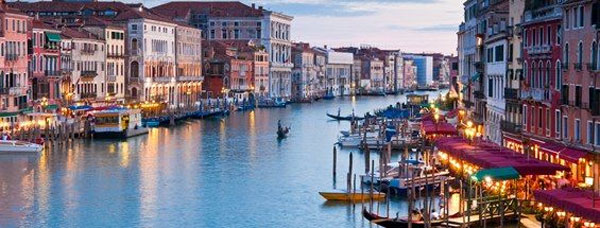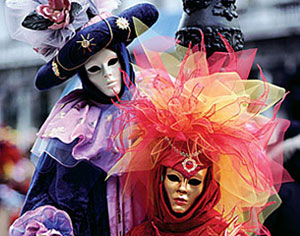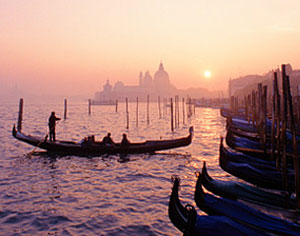Reply To:
Name - Reply Comment

One of Italy’s most famous cities, Venice really has to be seen to be believed. Comprising an archipelago of 117 islands in the marshy Venetian Lagoon, Venice rises directly out of the Adriatic sea and has substituted waterways in place of roads.
This curious ‘City of Canals’ dates back to the 5th century. During the next thousand years its strategic Adriatic position allowed the city state to develop into a major maritime power. By the late 13th century, Venice was the most prosperous city in all of Europe and its leading families vied with each other to build the grandest marble palaces and churches, balanced atop wooden posts driven deep into the mud and clay sea bed.
The influx of wealth influenced art, architecture and literature, with renowned Venetians including Marco Polo and Casanova. To this day Venice has a well-deserved cultural reputation courtesy of events such as the colourful Carnevale di Venezia, with its distinctive masks and costumes, and the Biennale di Venezia, a major contemporary art exhibition which incorporates the world-famous Venice Film Festival.
 Attractions
Attractions
Venice is small and sightseeing on foot is a very viable option; the Rialtine Islands (the 'main' part of Venice) are small enough to traverse in about an hour. However, the Grand Canal, which bisects Venice, has only four bridges across its three kms span. Venetians – and visitors in the know – avoid an unnecessary detour by crossing the canal on a two-oared gondola called a traghetto.
Venice has centuries of sights to see, but a classic Venice attraction is an activity: the traditional gondola ride. The shockingly high price is set by the Ente Gondola, or Gondola Board, but most agree it’s worth it; take time out from the crowds and experience Venice’s 170 narrow and winding canals from a different perspective.
Venice has many highlights, including the striking Basilica di San Marco. Admission is free but the queues can be lengthy. Adjacent to the Basilica is the Piazza San Marco which allows for a panoramic view of the Basilica. The best time to visit is at sunrise: avoiding the city’s 50,000 daily visitors is well worth the early start.
Behind the Basilica is the beautiful Ponte dei Sospiri or Bridge of Sighs. The name allegedly relates to the ‘sigh’ prisoners would sound as they walked over the Rio di Palazzo from the interrogation rooms in the Doge’s Palace to the prison. Visitors also flock to the 16th century Ponte di Rialto, a bridge over the Grand Canal and one of Venice’s most recognisable icons. Small shops line its sides, and the boat-dotted view over the Grand Canal demonstrates just how well Venice exists without cars.
 Dining and Nightlife
Dining and Nightlife
There’s a myth that says you can’t eat well in Venice: you can, but as with most things in Venice, dining out is expensive. However, a crowded restaurant or friendly maître d’ is not necessarily a sign of a good restaurant – with as many visitors per day as there are permanent residents, Venice restaurants are always busy. Consult an up-to-date guide book to avoid the tourist traps and guarantee a meal worthy of the setting.
Nightlife in Venice is also easier to find than the myth suggests. Venice largely empties out in the evenings as day trippers rush back over the causeway and Venetians (who eat far earlier than their mainland compatriots) hunker down for an evening in a bacaro. Regardless, there are still plenty of busy nightspots, easily spotted by the patrons who spill out onto the cobbled streets. Travellers looking for a late night should head to Dorsoduro or Cannaregio, but those who wish to go clubbing would do well to follow the Venetians lead and make their way across the causeway to Mestre.
Beyond Venice
Two hundred kms south of Venice is Florence, Tuscan city and birthplace of the Renaissance movement. Its museums and galleries feature classic paintings and sculptures by Michelangelo and Leonardo da Vinci, amongst others. Highlights include Michelangelo’s magnificent sculpture, David, which can be found at the Accademia Gallery, while other notable attractions include the exhibitions at Palazzo Pitti and the Uffizi Gallery, and the Ponte Vecchio, a closed bridge which dates back to the 10th century.